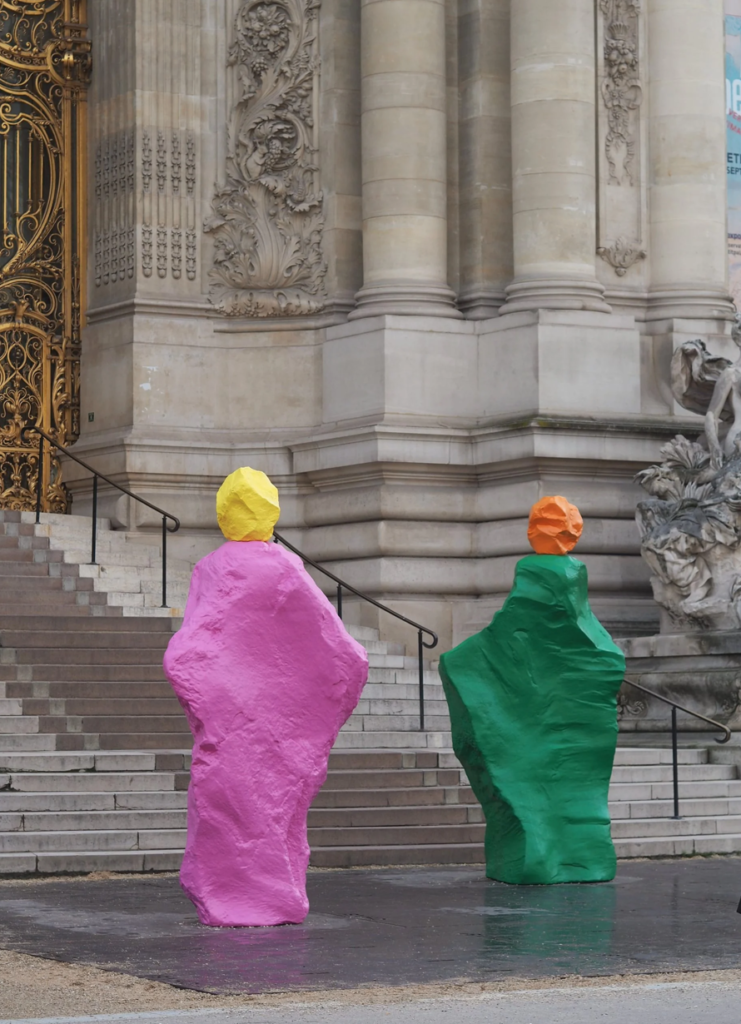IMAGES Devid Gualandris
WORDS Devid Gualandris
VIA Ignant
Every work in Ugo Rondinone’s distinctive oeuvre is imbued with emotion—a collection of intriguing ideas, bearing an infinite multitude of meanings exceptionally configured in ever-changing spaces. Regardless of the medium, his art cultivates a sense of wonder in its viewers, tantalizing them through a poetic filter and inviting them to themselves become part of the experience. At the unveiling of his new exhibition at the Petit Palais in Paris, coinciding with Paris+ par Art Basel, we had the rare opportunity to witness and listen to his wisdom.
Ugo Rondinone simply does not miss. If there’s one thing that the New York-based artist does best, it’s to always leave one entranced and visually awakened. We are no stranger to his incredible ability to envelop spaces and all who encounter them—we have been staggered by his works’ scale in Venice, just a few months ago. And yet, he never fails to surprise us. Last week was no exception. For his latest exhibition in Europe, Rondinone transformed the grandiose space of the Petit Palais—home to the City of Paris Museum of Fine Arts—into an emotional world for visitors to witness and engage with.

The artist, originally hailing from Switzerland, is an expert in evoking emotion, and has been since starting his poetic and eclectic career decades ago. Excellent at drawing from a young age, he picked up the interest for art on his own, extending his devotion to the contemporary realm by attending art school in Vienna and working in galleries. Today his work is featured in some of those same galleries—and in private and public collections all around the world. His latest exhibition combines the many themes that have shaped his practice over the years, namely nature, culture, and their intimate interconnection—symbols to which he returns time and again, revealing their complexities with every new show. Just like its title, the water is a poem, unwritten by the air, no. the earth is a poem, unwritten by the fire, the exhibition is a complex proposition—at once demanding and introspective—which the artist chose to communicate through different media, intricate symbols, and unique sensorial and spatial experiences.
The space of the Petit Palais is a jewel in itself—dazzling and towering, its size immediately forces you to raise your head to see it as a whole. There, hanging in the Rotunda Hall, are Rondinone’s humansky—an ensemble of suspended sculptural nude bodies of trapeze dancers embellished with a blue cloud-dotted sky camouflage. Visitors find themselves instantly captivated, their senses challenged. “The sculptures serve as vessels that contain the natural world of air and water,” says Rondinone, who was inspired for the project by Italian Renaissance paintings. The elemental theme progresses in the Sculpture Gallery with nudes, a series of sitting nudes spread among eighteen historical plaster sculptures from the Palais’s collection. Fragmented and in different brown tonalities, they depict the human-scale bodies of eleven Swiss male and female dancers at rest—self-absorbed and motionless as if in a meditative state. With nudes, Rondinone pushes sculpture to the edge of some avant-garde artistic proposition, raising it above a mere representation of nature. “The sculptures are made of wax and earth, sourced from all seven continents,” he explains. “They merge the element of earth with the human body, becoming one with nature.”

Rondinone’s interest in our collective relationship with the natural world is ever more prominent in the video artwork burn to shine—a world premiere and centerpiece of the show, installed inside a 10-meter-high sculptural cylinder made of charred wooden slats in the North Pavilion. Monumental and visible from afar, the structure has two doorways and is surrounded by four paintings by Eugéne Carrière—“a decision made by the artist,” notes Juliette Singer, chief curator of the Petit Palais. Inside it, an hexagonal room houses six screens projecting a captivating film. The film features 12 drummers and 18 dancers gathered around a fire in an unnamed desert. Performing an ancestral traditional Moroccan trance blended with contemporary dance gestures composed by Franco-Moroccan choreographer Fouad Boussouf, the different human bodies unite with nature from sunset until dawn, taking viewers into a trance state of spiritual liberation. “The initial inspiration for the work comes from a poem by John Giorno, which itself comes from a Buddhist saying describing the coexistence of life and death,” explains Rondinone. “This is similar to the much older Greek myth of the phoenix. According to the legend, a phoenix lived for 500 years. Just before its time was up, the phoenix built a nest and set itself on fire. Then at sunrise, a new phoenix arose from the ashes.”












IMAGES Devid Gualandris
WORDS Devid Gualandris
VIA Ignant
